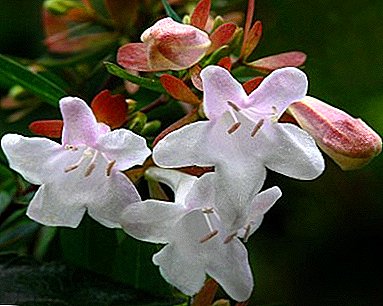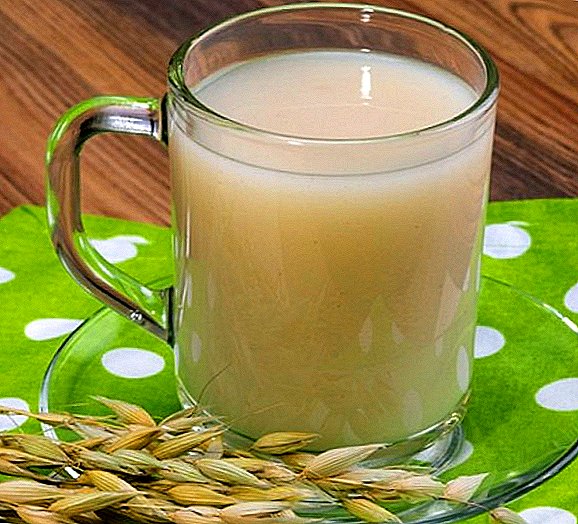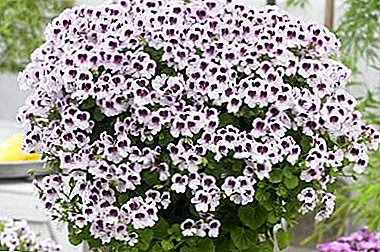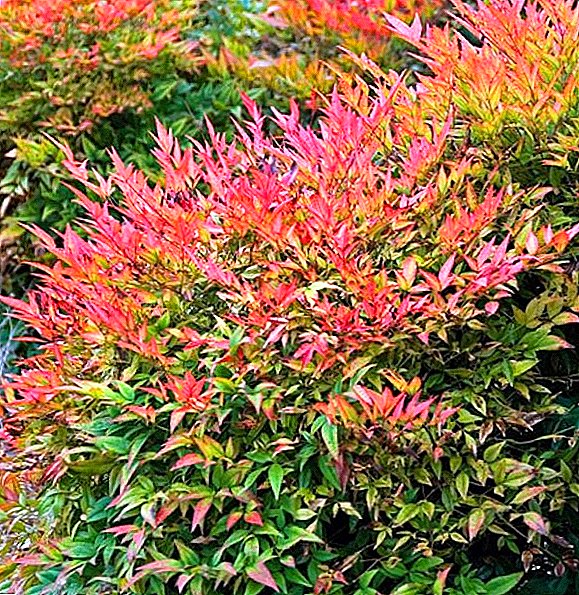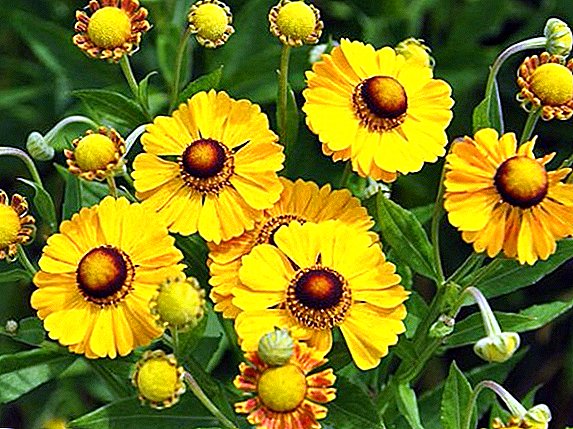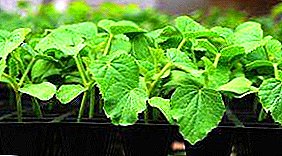 Often in the composition of drugs, hygienic and cosmetic products can be found such a component as an extract of soapwort medicinal. Let's see what kind of plant it is, consider its photo, and also find out what properties it has.
Often in the composition of drugs, hygienic and cosmetic products can be found such a component as an extract of soapwort medicinal. Let's see what kind of plant it is, consider its photo, and also find out what properties it has.
Plant description
Saponaria (soap grass) - This plant is a family of cloves. This is a herbaceous perennial with a small inflorescence. This flower is used as a decorative and can reach a height of 90 centimeters. To keep such a tall stem, the plant needs a wide root system.  The root system is powerful enough and with a color intensity from red to brown. In ancient times, the rhizome of a flower was used to make soap. Therefore, soap pot is also known as soap grass, soap root. You can also find such names as Tatar soap, dog and even kukushkino.
The root system is powerful enough and with a color intensity from red to brown. In ancient times, the rhizome of a flower was used to make soap. Therefore, soap pot is also known as soap grass, soap root. You can also find such names as Tatar soap, dog and even kukushkino.
The plant consists of bare and straight stems. They are located opposite and narrowed below the leaves that grow on short petioles. Flowers saponarii have a color from white to slightly pink.
Flowers are collected in paniculate inflorescence. The fruits are in an ovoid oblong box. Small dark seeds are in this box. Seeds ripen by August. Blossoms blooms from late May to late September.  There is a flower in the territory of Southern, Eastern and Central Europe, as well as in the Caucasus and Central Asia. This flower can grow on forest edges, glades, in thickets, along the banks of reservoirs, not far from residential buildings and even in wastelands. Many cultivate decorative soapwort in their own gardens.
There is a flower in the territory of Southern, Eastern and Central Europe, as well as in the Caucasus and Central Asia. This flower can grow on forest edges, glades, in thickets, along the banks of reservoirs, not far from residential buildings and even in wastelands. Many cultivate decorative soapwort in their own gardens.
Did you know? Ten species of saponaria grow in the CIS countries, and more than thirty in the Mediterranean.
Chemical composition
The root system of the soapworm is also called red soap root. The composition of the root includes such substances:
- carbohydrates;
- triterpene glycosides.
Among triterpene glycosides The root includes the following:
- saponaroside;
- saponaroside A;
- saponarosin D;
- saporubin.
 In the most foliage This plant contains the following substances:
In the most foliage This plant contains the following substances:- alkaloids;
- vitamin C;
- flavonoids.
In turn from flavonoids in the green of the plant are such subspecies of flavonoids:
- vitexin;
- saponarins;
- saponaretin
Saponins, which are found throughout the plant (both in the root and in the leaves) have surface-active properties. This property allows you to form a thick and resistant foam.
The presence of the healing properties of some plants is confirmed by their biological names: sage, wormwood, comfrey, peony, rosemary, hellebore, verbena, veronica, melissa have species with the designation "medicinal".
Beneficial features
This grass nine varieties, including both wild-growing, and decoratively deduced.
The extract of soap grass removes toxins from the human body and is also used as an antifungal and anti-inflammatory agent. Also, soap root improves metabolism.
The use of soapwort is useful for allergies, which react to chemicals from shampoos or other cosmetic foaming agents, as the plant is anti-allergenic. Also a useful property of soapy grass is its ability to adjust fatty skin balance.  Soap root - quite a popular tool in traditional medicine, which is used for a large number of various diseases. For these purposes, apply a special medicinal decoction, what it is - we will look further.
Soap root - quite a popular tool in traditional medicine, which is used for a large number of various diseases. For these purposes, apply a special medicinal decoction, what it is - we will look further.
Use in traditional medicine
This plant has a very wide range of applications in traditional medicine. Medicines that contain soapworm are recommended for use in such cases:
- angina;
- liver disease;
- spleen disease;
- bronchitis;
- pneumonia;
- jaundice;
- gastrointestinal tract diseases;
- constipation;
- furunculosis;
- cough;
- whooping cough;
- laryngitis;
- lichen;
- psoriasis;
- runny nose
- various polyarthritis;
- rheumatism;
- pharyngitis;
- cholecystitis;
- dropsy;
- scab;
- gout;
- eczema.
 If you regularly wash your hair with a decoction of saponarii, then this prevents baldness. The roots of the flower are used in diseases such as prostate adenoma, as well as frequent wetting, prostatitis and cervical cystitis.
If you regularly wash your hair with a decoction of saponarii, then this prevents baldness. The roots of the flower are used in diseases such as prostate adenoma, as well as frequent wetting, prostatitis and cervical cystitis.In traditional medicine, the plant is used in preparations for liquefying and expectoration of sputum, with problems of the respiratory tract. Also drugs from saponaria medicinal act as a laxative for constipation. It can also be used as a diuretic.
A decoction of soap grass is recommended to rinse the throat during a sore throat.
We advise you to read about the beneficial properties and the use in medicine of clover, elecampane, horsetail, bitter wormwood, gentian, quinoa, wild rosemary, camelling, yarrow, chervil, stevia, foxglove.
Tea
Tea from saponarii, more precisely from its crushed root, is used for anti obesity. To do this, you need 5-10 g of the substance to be finely chopped and throw boiling water into a cup. Bring the root of the soapwort to the boil and simmer for 15 minutes in a saucepan with a lid.
Leave the tea to infuse for an hour. Drink one cup of tea three times a day for two weeks. Take a break of 10 days, after which repeat the treatment course for a better result a couple more times.  Also the flower helps a lot when angina. To prepare medicinal tea against this disease, take the root of soapy grass and sage in a ratio of 1: 2, throw 30 g of the mixture of plants into a cup of boiling water, boil for 5-10 minutes and strain. Use this tea to rinse.
Also the flower helps a lot when angina. To prepare medicinal tea against this disease, take the root of soapy grass and sage in a ratio of 1: 2, throw 30 g of the mixture of plants into a cup of boiling water, boil for 5-10 minutes and strain. Use this tea to rinse.
If you have a strong cough, this decoction may well help you. But instead of sage, use the leaves of soapworm along with the root. Fill the mixture with 200 ml of very hot water, let it brew for 3 hours. Bring the amount of tea to the original, by adding boiled water, and take this tea twice a day. If the cough is strong, add chamomile to the tea and make a compress with it.
Natural medicines can be found in your own kitchen, garden or flower garden: mint, lemon balm, oregano, cardamom, cloves, nutmeg, horseradish, spinach, parsley, bay leaf, dill, borage, marigolds, cornberry, echinacea have healing properties.
Decoction
Many recommend the use of a decoction of this plant when herpes. To do this, take 20 g of the root and cover it with very hot water, boil for 5 minutes over low heat. Use decoction in compresses on the affected areas.
Did you know? The genus name Saponarius is derived from lat. "sapo", which can be translated as soap, this name is explained by the ability of the root to form foam.
Also, the root decoction has proven itself in rheumatoid arthritis and rheumatism. Enough one teaspoon of root, which you pour a cup of boiling water and boil a quarter of an hour in a water bath. Add boiled water to the broth to get the volume of one cup. Take a decoction a glass, 4 times a day after meals, for two weeks. After one course of treatment, take a break of 10 days, then repeat the treatment once or twice. 
Infusion
Let's look at how to make an infusion of soapwort rhizomes.
Crush to start 5 g of roots. Then fill the roots with a glass of boiling water and let it brew for 4 hours. Use 2 tablespoons of broth three times a day after meals, with furunculosis and similar diseases.
Important! A large amount of broth from mylnyanki can be poisoned, a sign of poisoning will be a sweet-burning taste in the mouth and a feeling of mucus formation.
Cosmetology, nutrition and other applications
In cosmetology, the extract of this flower is added to shampoos, in the means for dishes. And since this extract also regulates the fat balance of the skin, it is added to cosmetic preparations for problem skin and sensitive skin. Thanks to saponins, soapworm is added to the means for washing things made of wool and silk products, as well as to get rid of stains on clothes. Saponins are used in cooking. They are used in the preparation of cream, beer, carbonated drinks and even halva.
Also, soap extract is used in dietetics to improve metabolism and to remove harmful toxins from the body.
Mylnyanka is used in veterinary medicine as an antihelminthic and in diseases of the gastrointestinal tract.
It will be useful for girls to learn how to use rosemary, lettuce, marjoram, coltsfoot, calendula, nettle, enoteru, periwinkle, savory, parsnip for cosmetic purposes.
Contraindications
Mylnyanka is a very poisonous plant. When overdose appear such side effects:
- nausea;
- diarrhea;
- abdominal pain;
- vomiting;
- cough.
 Symptoms of poisoning myalnyanka is a sweet taste, which later becomes burning with a sensation of mucus. When these symptoms appear, you should immediately stop using soapbox.
Symptoms of poisoning myalnyanka is a sweet taste, which later becomes burning with a sensation of mucus. When these symptoms appear, you should immediately stop using soapbox.In case of poisoning, an urgent need to wash the stomach.
Important! For washing use 2% solution of soda (sodium bicarbonate) with the addition of activated carbon.After washing the stomach, you must appoint enveloping drugs.
Soap root extract is quite common and covers a large scope. Proper use of this plant will get rid of a number of diseases. Before use, be sure to check if you are allergic to substances that are part of the plant.




